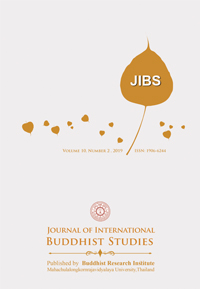Clinical Buddhist Chaplaincy Spiritual Care Supply and Demand in the US Healthcare System
Keywords:
Clinical Buddhist Chaplain, Spiritual Care, Emotional Support, InterfaithAbstract
This study presents the findings of a statistical analysis exploring the correlation between supply and demand of clinical Buddhist chaplaincy in the US healthcare system. Quantitative data collected from the field (n=993; total visits(tv.)=1,188) analyze different aspects clinical Buddhist chaplaincy work with regard to patients’ spiritual care needs and the distribution of patient ethnicity, religious/spiritual preference and geographical origin. Insights obtained from the data support a positive and strong correlation between patient spiritual care needs and the work of a clinical Buddhist chaplain as a spiritual care provider.
References
Danny Fisher. Benefit Beings! The Buddhist Guide to Professional Chaplaincy. CA: Off Cushion Books, 2013.
Babbie, Earl R. The Practice of Social Research.14th edition. CA: Wadsworth Publishing, 2014.
Battey, Bonnie W. “Perspectives of Spiritual Care for Nurse Managers.” Journal of Nursing Management 20 (2021): 1012-1020.
Cadge, Wendy and Shelly Rambo. Chaplaincy and Spiritual Care in the Twenty-First Century: An Introduction. US: The University of North Carolina Press, 2022..
DeMaioNewton, Emily and Karen Jensen. Buddha Buzz Weekly: Interest in Buddhist Chaplaincy Increases During the Pandemic. Accessed October 10, 2022, https:/ /tricycle.org/article/buddhist-chaplaincy-pandemic.
Flannelly, Kevin J. et al. “A National Survey of Hospital Directors’ Views about the Importance of Various Chaplain Roles: Differences among Disciplines and Types of Hospitals.” Journal of Pastoral Care and Counseling 60 (2006): 213 –225.
Giles, Cheryl A. and Willa B. Miller. The Arts of Contemplative Care: Pioneering Voices in Buddhist Chaplaincy and Pastoral Work. Boston: Wisdom Publications, 2012.
Harris, Marilyn D. and Lamont R. Satterly. “The Chaplain as a Member of the Hospice Team.” Home Healthcare Nurse 6 (1998): 591-593.
Kandil, Caitlin Y. Pandemic’s Suffering Opens Way for Buddhist Chaplains .ccessed October 10, 2022. https://religionnews.com/2020/12/02/pandemics-suffering-opens-way-for-buddhist-chaplains.
Mandziuk, Paul A. “Is There a Chaplain in Your Clinic?.” Journal of Religion and Health 35 (1996): 5 -9.
Mason, Edna C. “The Changing Role of Hospital Chaplaincy.” Reformed Liturgy and Music 24 (1990): 127-130.
Michele Shields, Ellison Kestenbaum, and Laura B. Dunn. “Spiritual AIM and the Work of the Chaplain: A Model for Assessing Spiritual Needs and Outcomes in Relationship.” Palliative and Supportive Care 13 (2015): 76.
Phillips, Ambrose K. “The Chaplain's Role in a Nursing Home.” Hospice Progress 56 (1973): 75-78.
Reed, Allan W. “Images of the Hospice Chaplain.” Hospice Journal 1 (1985): 111-118.
Savel, Richard H. et al. “The Importance of Spirituality in Patient-Centered Care.” American Journal of Critical Care 23 (2014): 277.
Snowden, Austyn. “What Did Chaplains Do During the Covid Pandemic? An International Survey.” Journal of Pastoral Care & Counseling 75 (2021): 12.
Tan, Heather et al. “Understanding the Outcomes of Spiritual Care as Experienced by patients.” Journal of Health Care Chaplaincy 28 (2020): 155.
Zhen, Guan. “Buddhist Chaplaincy in the United States: Theory-Praxis Relationship in Formation and Profession.” Journal of International Buddhist Studies 13 (2022), 51.







